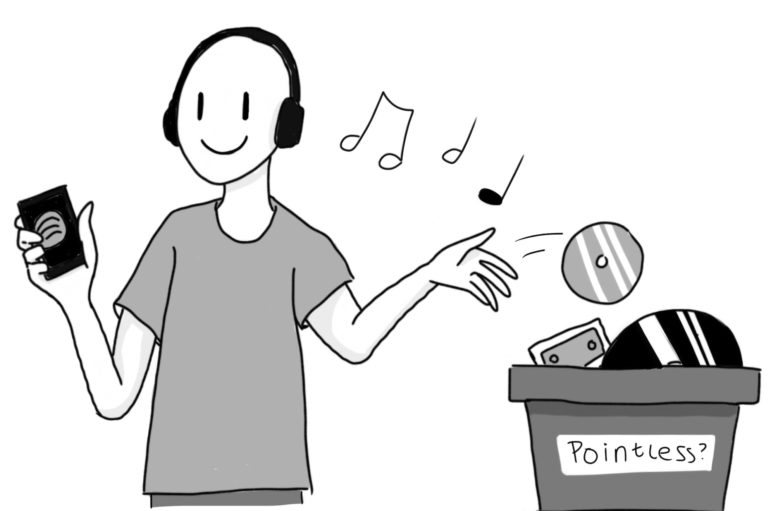
It’s a normal day. Students are walking around center court and the air is filled with voices and footsteps. After listening to this same monotonous soundtrack of school for hours on end, a student thinks to himself, “I feel like listening to some music.” He lugs a giant boombox out of his backpack, slips in a CD, hefts it over his shoulder, and cranks up the volume for all to hear.
This may have been a normal day twenty years ago, but in today’s world of Spotify and Apple Music, one likely won’t find John Cusack standing outside their window blasting a romantic song from their boombox, but instead someone playing their Soundcloud mixtape through a bluetooth speaker.
Physical albums are on the decline, and streaming is on the rise. The charm and tradition of physical albums simply can’t compete with the functionality and accessibility of streaming services. Times are changing, and so is the way we collect and consume music. According to Forbes, streaming in 2017 totaled to 65 percent, or $5.7 billion, of the recorded music industry. With this upward surge of streaming also comes the rise of the music industry at large, seeing its third consecutive year of growth in 2017 following a 15-year declining streak, Variety reports.
Even artists themselves are beginning to recognize the decline of physical albums’ appeal.
“I was thinking about not making CDs ever again… only streaming,” said hip-hop artist Kanye West in 2016. Although West is still selling CDs, it speaks volumes that artists are beginning to place less emphasis on the sale of physical albums.
And it’s not just contemporary artists or the more radical Kanye Wests of the industry; seasoned artists whose careers were built on the sale of physical albums are changing the way they market their albums. One of these artists is Paul McCartney, a quarter of the iconic Beatles whose fame was built on the backs of CDs, vinyls, and cassette tapes. On The Tonight Show, while showing off the complex design of his packaged album, McCartney said, “If people are going to pay hard-earned money… you’ve gotta give them some value.” Pricey CDs pale in comparison to free or cheaper streaming services of YouTube. In order to drive sales, artists now need to sell more than just a CD in their physical albums.

Although physical albums’ reign over the music industry has undeniably come to an end, this decline definitely doesn’t mark the end of an era of CDs and vinyls.
Physical albums still have a substantial stake in the industry, continuing to beat out digital ones with 87.6 million copies sold in 2017 to digital’s 66 million according to Forbes. It hasn’t survived in the industry for this long for no reason, and the fact that it held its ground despite the massive blow of streaming assures its place in the future of music.
An unexpected force has also emerged in the realm of physical albums. Over the past few years, vinyls have migrated over from vintage shops and small independent music stores to mainstream fronts like Urban Outfitters, Target and Barnes and Noble. It seems that vinyls have conquered the days of collecting dust in basements and are now back on their turntables, adding substantial numbers to the industry.
Perhaps vinyls are no longer a thing of the past but the future of the physical album market.
According to Billboard, sales have been steadily rising over the past 12 years, accounting for 8.5 percent of all album sales in 2017. The top ten selling vinyls feature a diverse mix of music, from The Beatles, to the La La Land soundtrack to Ed Sheeran. The market for vinyls isn’t just for hipsters or collectors but is built up by a solid population of consumers as diverse as CDs, streaming, or music itself.
Teenagers especially have become captivated by the old school charm of vinyls, including former Aragon student Nur Schwartz who keeps her own collection of vinyls.
“It makes me [think about] days I wasn’t alive and wish I was,” Schwartz said, “And it’s cool because they’ve modernized it and I’m able to listen to my own favorite artists now too.” [Unlike streaming] I’m able to hold it and… physically see my music.”
Music is universal, timeless and endlessly diverse; from hip hop to country to screamo, there’s something for everyone. Despite the domination of streaming and seeming downfall of physical albums, it only makes sense that the music industry will continue to evolve.



